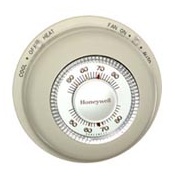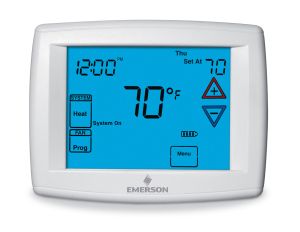Oh-Ho-Ho It’s Magic!
You may not appreciate this fact very often, but you live in an amazing time. Imagine going back 500 years and announcing that you had the power to control temperature. People would be astounded…and you most likely would be accused of witchcraft and end up in some very hot water, so you probably shouldn’t make that claim if you ever do go back in time, but the point remains: it’s easier than ever to create your ideal living environment.
In this post, you will learn about your air conditioning system’s command center and some steps you can take to make you a better commander.
Don’t Touch That Dial
The word thermostat comes from the Greek words thermos (hot) and statos (standing), but the actual device is far from an ancient invention and has only been around since the late 19th century. At that time in much of the West, if you wanted to cool off, you took yourself outside and dunked your head into a horse trough. The thermostat, paired with the air conditioning innovations that were made in the decades after, made cooling off a much easier (and drier) proposition.

An old school round thermostat.
Early thermostats were clunky, mechanical and not terribly accurate, but the important point was room temperature could be measured and controlled. Greater precision and user-friendly designs would soon follow and give rise to the circle, square or rectangle on the wall in your childhood home that you weren’t allowed to play with.
Since thermostats rarely need to be replaced, there is still an abundance of these old models still in use and the thermostat you have now may indeed just be a simple case with a dial on it. If this is your current situation, operation is as simple as it can get, but we’re now in the digital age and many thermostats nowadays have more capabilities. With these added capabilities comes a steeper learning curve, but there are some definite added benefits.
Get with the Program
Today’s thermostats are smart. And the ones of tomorrow will be even smarter. Controlling your environment’s temperature is no longer limited to simply making it cooler when it gets hot and making it warmer when it gets cold. Of course, the basic concepts are still there, but now with a few taps of the screen you can tell your environment to work around your weekly schedule.

A modern White-Rodgers programmable touchscreen thermostat.
Wait, what’s this about tapping screens?

A modern White-Rodgers programmable touchscreen thermostat.
Like a lot of modern electronic devices, many thermostats are using touchscreen technology. If you don’t have much practice with touchscreen displays, don’t be intimidated. They’re extremely easy to use. Touchscreen thermostats also light up, so if you’re stumbling to your thermostat at 3AM and don’t want to blind yourself by flicking on a light switch, you won’t have to.
…However, if you’ve come to the conclusion that touchscreens drive you nuts, there are still plenty of good thermostats that have buttons.
Okay, so what’s programmable about this thing?
Programmable thermostats are programmable in that they allow you to set time/temperature programs. You assign temperatures for days of the week and times of the day and the thermostat executes the program until you change it or tell it to stop.
If you’ve browsed programmable thermostats before, you may have seen a few different types with numbers that look like football formations. If you were wondering what the differences are, here are some descriptions:
- 5-2 Day Programmable – You’re able to make two schedules. One for weekdays and one for weekends.
- 5-1-1 Day Programmable – Three schedules can be made. One for weekdays, one for Saturday and another for Sunday.
- 7 Day Programmable – These have the most flexibility and programs can be set for each day.
In choosing which programmable thermostat is the best for you, think of your household’s daily schedule. If you have a typical 40 hour a week schedule and the weekend off, a 5-2 should be fine. For those with regular activities during the weekend, you might go with a 5-1-1. A 7 day programmable thermostat will be the best option for people with schedules that are constantly changing and/or have big families.
What other features to watch for…
Most of the newer programmable thermostats competing for attention will have many of the same features but, in doing some comparison shopping, you might want to look for mention of the following:
- +1/-1 degree accuracy.
- Real-time clock to account for seasonal time changes.
- Program retention in a power outage.
- Indicators for telling you when to change your filter.
- Auto heat/cool changeover option.
- Warranties.
- Locks and overrides for inevitable family thermostat warfare.
Programmable thermostats, even ones with a fair amount of the above features, are becoming increasingly more affordable. And compared with the total cost of your system and even the energy to run it, it’s worth investing a fraction of those costs in getting a good thermostat and having it professionally installed.
The real beauty of a programmable thermostat is that you have greater power over the energy consumption of your heating and cooling system. And with smart settings, you can save a lot of energy and money.
Settings for Savings
Here’s the great news about achieving energy savings with a programmable thermostat: the settings are already pre-programmed. There’s no secret formula involved. Of course, you can still customize your programs, but for people who don’t want to spend a lot of time on fine-tuning their schedules, the pre-programmed settings are the way to go.
Here’s a table of a sample program that will save you over 10% on your energy bills:
|
Setting |
Time |
Setpoint Temp (Heat) |
Setpoint Temp (Cool) |
|
Wake |
6AM |
? 70° F |
? 78° F |
|
Day |
8AM |
Setback at least 8° F |
Setup at least 7° F |
|
Evening |
6PM |
? 70° F |
? 78° F |
|
Sleep |
10PM |
Setback at least 8° F |
Setup at least 7° F |
This is just a sample and times and temperatures can be adjusted according to your own preferences, but the point to take from it is setting your thermostat back when you’re away or asleep is an easy way to save without sacrificing comfort.
Some other things to know…
- Keep your fan on “AUTO” instead of “ON”. Having the fan on continuously consumes more energy and can circulate humid air.
- Try not to override or “hold” while your program is running. You’re asking your system to use more energy.
- Avoid using the hold and vacation features as daily settings. It’ll keep eating power (your money) while you step out.
- Don’t go excessively cranking the temperature up/down to make the system work faster, because it won’t. In fact, it will think you’re being pretty rude and will quietly resent you for a while.
Now You Know the Stats
So, there’s a little information about thermostats. There are probably several other electronic gadgets you would rather play with, but this one could save you some money and comfort, so it’s a good idea to study your user’s manual and figure out how to best use it. Four Seasons technicians will also be more than happy to get you off to a good start if you choose us to install a programmable thermostat for you. Contact us here or at our number at the bottom of the screen and we can discuss your options.

